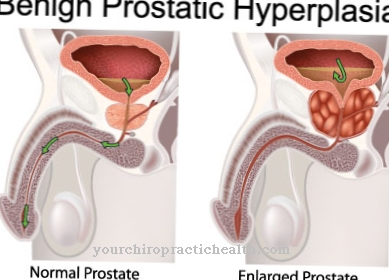The Cervical rib syndrome is one of the bottleneck syndromes. It is also known as the scale syndrome.
What is cervical rib syndrome?

© mikiradic - stock.adobe.com
In medicine, the cervical rib syndrome is also called Scale syndrome or Naffziger Syndrome designated. What is meant is thoracic outlet syndrome (TOS). The cervical rib syndrome is a bottleneck syndrome. It is formed by compression of nerves and blood vessels in the scalene gap.
The brachial plexus (arm plexus) is pinched within the scalenus gap between the scalenus medius and the anterior scalenus muscles. The cervical rib syndrome is also one of the nerve compression syndromes. At the present time, medicine summarizes the cervical rib syndrome under the comprehensive name of thoracic outlet syndrome.
This is characterized by neurovascular compression syndromes that occur in the upper chest (thorax). The frequency with which the cervical rib syndrome occurs could not be determined.
causes
A compression of the brachial plexus and the subclavian artery is responsible for the cervical rib syndrome. Both structures are located within the so-called scalenus gap. The compression can be triggered by a cervical rib, hypertrophy of scalene muscles or disruptive ligament structures.
The nerve plexus of the affected arm runs along the arms over the shoulders to the chest. The scalenus gap is located between the ribs and the cervical vertebrae, in which the musculus scalenus medius and the musculus scalenus anterior are accommodated. This point can become a bottleneck if a second neck rib is located there.
Excess cervical ribs are one of the most common causes of cervical rib syndrome. In addition to bony structures, muscles with hypertrophy are also responsible for the occurrence of cervical rib syndrome. The excessive size of the muscle tissue causes the arm nerve plexus to become narrow.
In some cases, cervical rib syndrome is caused by an exostosis or a steep incline of the upper ribs. During this process, not only can the strands of the brachial plexus be affected by compression, but also the strands of the subclavian artery.
You can find your medication here
➔ Medicines for paresthesia and circulatory disordersSymptoms, ailments & signs
Typical symptoms of cervical rib syndrome include neuralgiform pain that occurs in the arm and shoulder. The ulnar side of the lower arm is particularly affected. The triggering reason is the motor innervation of the brachial plexus of shoulder muscles and chest muscles. The arm plexus also plays a role in the sensory and motor innervation of the hand and arm.
Since the compression leads to disturbances of the sensitive innervation of the hand, paresthesia and hypoesthesia are also evident in the hand. These are sensory disturbances that are associated with circulatory disorders. This is especially true when the subclavian artery is also affected by the nerve compression. The disturbance becomes noticeable through the frequent falling asleep of the arm.
It is not uncommon for those affected to suffer from feelings of heaviness and numbness. Some patients later complain of paralysis of the chest and arm muscles, which is due to the motor innervation of the brachial plexus in this region of the body.
In the advanced stage of the cervical rib syndrome, small blood clots are also possible due to narrowing of the subclavian artery. This creates the risk that the finger vessels will become blocked, which will discolor the fingers.
Diagnosis & course
If you suspect a cervical rib syndrome, a visit to a doctor is recommended. Based on the typical symptoms of the syndrome, the medical professional will perform various tests. With a scalene syndrome, for example, the wrist pulse can no longer be felt if the head is stretched backwards, the patient turns to the painful side and inhales at the same time. This tension causes the scalene muscles to thicken.
The doctor listens to the collarbone with the stethoscope and perceives a noise. This is considered to be an indication of a narrowing of the arteries. X-rays are also important in the case of cervical rib syndrome. In this way, additional neck ribs can be identified in the pictures. The excess cervical rib exerts pressure in cervical rib syndrome.
Furthermore, thickenings or changes in shape of the first rib can be seen on the X-ray images. The exact location at which the blood vessels are narrowed by the syndrome can be shown with a sonography (ultrasound examination).
The differential diagnosis is also important because the cervical rib syndrome must be differentiated from other thoracic outlet syndromes. In principle, there is a favorable prognosis for a cervical rib or scalene syndrome. In most cases a complete cure is possible.
Complications
In the case of cervical rib syndrome, the patient is primarily exposed to severe pain. These pains mainly occur in the arms and shoulders and often lead to restricted mobility or other restrictions in everyday life. The pain can also occur in the form of resting pain and can also burden the patient at night.
This can lead to sleep disorders and general irritability of the patient. It is not uncommon for the pain to spread to other regions of the body. Furthermore, there are sensory disorders and circulatory disorders. The typical tingling sensation occurs, whereby the extremities can show slight paralysis.
In severe cases, severe paralysis and sensitivity disorders occur. Due to the paralysis, the patient's actions are extremely limited and the quality of life is considerably reduced. Furthermore, the blood vessels in the fingers can become blocked. Treatment takes place either through surgery or with the help of medication.
However, the course of the disease cannot be predicted, as this usually depends on the severity of the cervical rib syndrome. The syndrome does not reduce life expectancy. However, it is possible that certain paralysis and disorders cannot be completely removed, so that the patient will suffer from them for a lifetime.
When should you go to the doctor?
In the case of cervical rib syndrome, a visit to a doctor is always necessary. If the symptoms of the syndrome are ignored, permanent paralysis or numbness can result, which can no longer be treated. As a rule, the doctor should be consulted if there is pain in the arm or shoulder for no particular reason.
Decreased motor skills of the arm can also indicate the cervical rib syndrome. Furthermore, sensory disturbances or disturbances of the blood circulation represent a common symptom of this syndrome. In particular, a constant tingling sensation in the affected region can indicate the syndrome and should be examined. A doctor should be consulted at the latest in the event of persistent numbness. The discoloration of the fingers can also indicate the disease.
Rib neck syndrome can usually be diagnosed by an orthopedic surgeon or general practitioner. However, the treatment takes place with the help of various exercises and therapies. Whether there will be a complete healing cannot be universally predicted. An early diagnosis always has a positive effect on the course of the disease.
Doctors & therapists in your area
Treatment & Therapy
Complex therapy is not always required for cervical rib syndrome. Treating the pain is usually sufficient for mild processes. For this purpose, local anesthetics are applied to the affected scalene muscles.
It is also important that the patient avoid movements or strains that trigger or exacerbate pain. In this way, the use of analgesics can be reduced. In some cases, treatment of neurological complaints such as paralysis may also be necessary.
Such treatment should be carried out in good time so that the affected nerve plexus does not suffer permanent damage. If the neurological deficits of the cervical rib syndrome are pronounced, a surgical procedure must often take place. The affected cervical rib, which exerts pressure on the arm nerve plexus, is removed. This will eliminate the main cause of compression.
Outlook & forecast
The prognosis of cervical rib syndrome is classified as favorable. In a large number of cases, a few treatment steps lead to significant relief of the symptoms. Often symptoms are free within a few days.
Side effects and risks can occur with drug therapy. In addition to intolerance, other complaints can develop. When the drug is discontinued, spontaneous healing occurs, as the active ingredients are completely removed from the organism within a short time.
If, in spite of the symptoms, the body continues to undergo severe stress, complications can arise. In severe cases, there is a risk of permanent damage to the skeletal, muscular or nervous system. Therefore, sufficient rest and rest during the healing process is necessary for a good prognosis. Subsequently, a new load should take place gradually so that excessive demands are avoided.
If surgery is performed, complications can also arise. Although it is a routine process, there are potential risks with any surgery. If the procedure is successful, the patient will quickly experience an improvement in their health.
If a cervical rib syndrome develops again in the course of life, the prognosis is also favorable. Nevertheless, it should be taken into account that overall instability of the skeletal system occurs with increasing age and that this is increased when a cervical rib is removed.
You can find your medication here
➔ Medicines for paresthesia and circulatory disordersprevention
There are no effective measures to prevent rib cervical syndrome. The disease is mostly caused by excess neck ribs. However, these are already innate. At least it is possible to prevent the pain of the cervical rib syndrome by avoiding pain-inducing stress.
Aftercare
In the case of the rib cervical syndrome, early detection of this disease is very important. Only through early detection can further complications be prevented. The person affected should consult a doctor at the first symptoms and signs of the disease so that further symptoms can be prevented.
The focus is therefore on a quick diagnosis, although the measures and options for follow-up care for cervical rib syndrome are severely limited. With the help of medication, the symptoms can be reduced. The person concerned should always take the medication according to the doctor's instructions and observe the correct dosage.
High physical strain should also be avoided in order not to strain the muscles unnecessarily. The person concerned should also not engage in stressful activities and should rest frequently. It is not uncommon for the help and support of friends or family to be necessary to relieve the patient in everyday life.
However, in some cases of cervical rib syndrome, surgery is also necessary to relieve the symptoms. After such an operation, the person concerned should also rest and remain in bed. Physiotherapy measures can also alleviate the symptoms, although many exercises from such therapy can also be performed in your own home.
You can do that yourself
Mild neck rib syndrome can be treated with pain relievers. This therapy can be supported by protecting the arm and shoulder until the symptoms have subsided. Exercises from physiotherapy as well as sporting activity help against circulatory disorders.
In consultation with the doctor, alternative measures such as acupuncture, massages or methods from Chinese medicine are also possible. The prescribed pain medication may also be supported by alternative means. The South African devil's claw, for example, helps with pain and soothes inflammation. Willow bark and curcumin have a similar effect.
In addition, any neurological complaints must be treated. Paralysis can be reduced through physiotherapeutic measures. Therapy can be supported at home with gymnastic exercises and yoga.
If the neurological damage is severe, surgery is necessary. Then rest and bed rest are the most effective support. The area around the procedure must be checked regularly by a doctor. If symptoms arise again after recovery, it is best to speak to the responsible doctor. In the case of major complications, such as acute pain or movement disorders, the emergency medical service is the right contact.


.jpg)



.jpg)




















